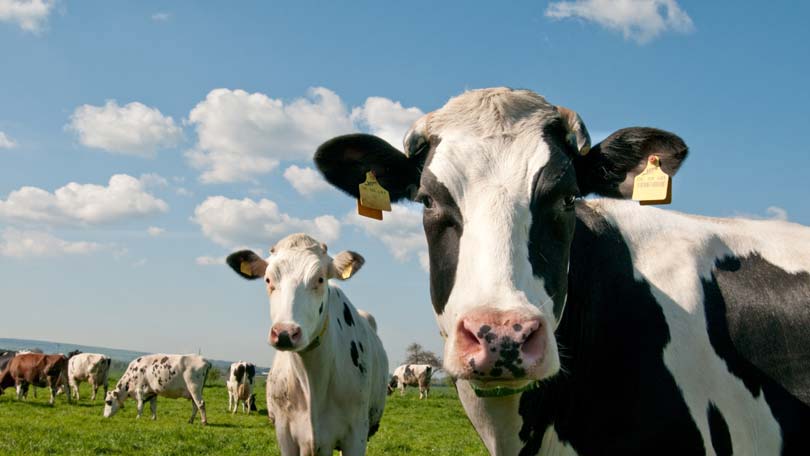Organic milk is seeing a huge rise in revenue as more consumers are willing to spend money on products that they feel are healthier and safer for their families. An industry currently under scrutiny for inconsistent practices among organic sellers, organic milk farmers are benefiting from a rise in profits, but even disagree among themselves about the proper treatment of organic milk cows. At a price two to three times higher than regular milk, organic milk is presenting under-informed buyers with a tough decision; are the benefits of organic milk worth the cost; or is that organic label on milk just a way to increase revenue without offering added benefits to milk drinkers?
The USDA (United States Department of Agriculture) has set up guidelines for organic milk which must be produced following four basic principles. First, organic milk has to come from cows not treated with rBGH (bovine growth hormone), which is used among conventional milk farms to increase milk production. The cow must also be kept free from antibiotic use. Any sick member of an organic herd that needs antibiotics due to illness can be treated, but must be kept separate from the organic herd for a full year. Third, the cow’s food must be grown pesticide free – most cows eat either grasses or grains, and either one must be produced by organic farming (the use of organic feed may actually help to support organic farming practices as the demand for organic feed is increased). Finally, the cow must have time to graze freely in pastures during the growing season. Currently, the exact amount of grazing time is unspecified; this final principle has caused controversy within the organic milking community as some larger producers only provide a short amount of grazing time for their cows, keeping them in feed lots for most of the year.
Though the health benefits of organic milk are highly debated, research presented by the Danish Institute of Agricultural Research showed organic milk to have higher levels of vitamin E, omega 3 fatty acids, and antioxidant levels than conventional milk. Milk was tested in cows from organic farms and conventional farms, with organic cows producing milk 50% higher in vitamin E and 2-3 times higher in beta carotene and antioxidants lutein and zeaxanthine (thought to ward off infections and diseases). This study concluded that the increased nutritional benefits were due to the organic cows being allowed to graze freely on grass as opposed to being kept in holding pens or feed lots.
Although many organic milk consumers buy organic to avoid antibiotics and growth hormones, many really are more scared by speculation – not the facts. The rBGH used to treat cows and increase milk production is actually a protein hormone that would be digested in a human’s gut if any were present in consumed milk. This BGH increases a certain growth factor in cows (IGF-1); IGF-1 is only slightly higher in milk from BGH cows than milk from non-BGH cows. High IGF-1 levels in humans are thought to increase risk for cancer but, humans produce more IGF-1 in saliva and digestive secretions each day than could be ingested with 95 quarts of conventional milk. High IGF levels are more closely related to obesity and diets high in saturated fat. Also, conventional cow’s milk is routinely tested for antibiotics before it is allowed into the marketplace. If a test shows any level of antibiotics, the milk is not sold. The real difference in organic milk comes from the organic cows’ ability to graze freely on organic grasses.
Unfortunately, buying organic milk does not guarantee that you are buying milk from open pasture grass-grazing cows. Roughly 30% of organic milk sold comes from confinement dairies where the cows are allowed very little pasture time. Hundreds of organic farmers and organic milk drinkers are pushing for stricter USDA guidelines on the amount of pasture time that must be given to organic cows so that all organic milk is produced under the same conditions. Some smaller local diary farms that are not certified organic will allow their cows to graze on pasture, so picking up milk from a local farmer may be a good option to ensure that the milk your family consumes has the higher nutrient content of grass fed grazing cows.
Now accounting for 3% of the entire milk market in the United States, organic milk has an annual growth rate of 23% in a time when total milk consumption decreases by 8% each year. It is available in many large grocery chains including Wal-mart. Not all organic milk is the same however; some organic farms use less than ideal methods to produce organic milk, narrowly passing vague USDA regulations. If you are really interested in buying the healthiest milk available, see if any local dairy farmers sell their milk nearby, and ask about their farming practices – you can support local growers and possibly buy healthier milk at a lower cost. If that is not available, research the organic milk brands that are in your supermarket. Find out which one has the best production practices and buy that one; until the USDA creates stricter guidelines for organic milk producers, each consumer will have to research and choose wisely when buying organic milk.






